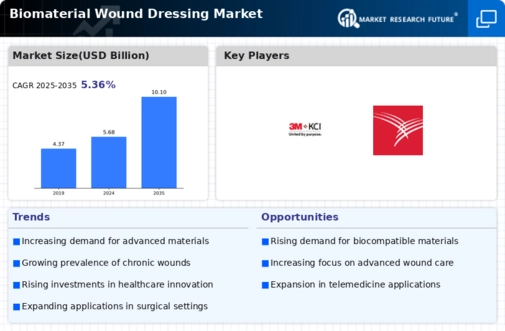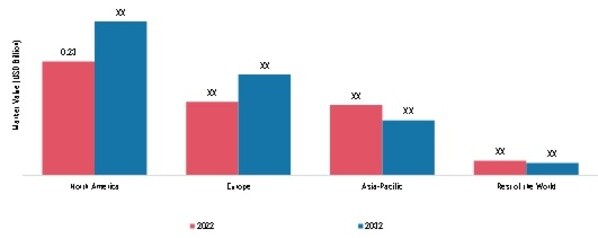Market Share
Introduction: Navigating the Competitive Landscape of Biomaterial Wound Dressings
The biomaterial wound dressing market is being reshaped by a rapid uptake of new technology, an evolving regulatory framework and an increasing focus on the efficacy and sustainability of products. IT companies, system integrators and new entrants are striving to exploit advanced digital and analytic capabilities to improve wound care and patient outcomes. In the meantime, established players are focusing on automation and green production to ensure compliance with regulations, while disruptive newcomers are developing novel biomaterials that offer superior healing properties. Strategic approaches are evolving in line with the development of regional markets, particularly in North America and Asia-Pacific. The trend is towards localised manufacturing and a more tailored approach to marketing. The future of this market will be decided by a clear understanding of the technological and clinical differences between products.
Competitive Positioning
Full-Suite Integrators
These vendors offer comprehensive solutions across the biomaterial wound dressing spectrum, integrating various technologies and services.
| Vendor | Competitive Edge | Solution Focus | Regional Focus |
|---|---|---|---|
| Smith & Nephew (UK) | Strong brand recognition and innovation | Advanced wound care products | Global |
| 3M (US) | Diverse product portfolio and R&D | Medical and surgical supplies | Global |
| Mölnlycke Health Care (Sweden) | Focus on sustainability and quality | Wound care and surgical solutions | Europe, North America |
| ConvaTec, Inc (UK) | Strong focus on patient outcomes | Wound and skin care products | Global |
Specialized Technology Vendors
These vendors focus on niche technologies and innovative solutions within the biomaterial wound dressing market.
| Vendor | Competitive Edge | Solution Focus | Regional Focus |
|---|---|---|---|
| Acelity (US) | Expertise in advanced wound therapies | Negative pressure wound therapy | North America, Europe |
| Coloplast Corp (Denmark) | Strong emphasis on user-friendly products | Wound and continence care | Europe, North America |
| Derma Sciences, Inc (US) | Innovative wound care solutions | Advanced wound dressings | North America |
Infrastructure & Equipment Providers
These vendors provide essential equipment and infrastructure that support the application and effectiveness of wound dressing solutions.
| Vendor | Competitive Edge | Solution Focus | Regional Focus |
|---|---|---|---|
| B. Braun Melsungen AG (Germany) | Comprehensive medical device offerings | Surgical and wound care products | Global |
| Cardinal Health (US) | Extensive distribution network | Healthcare supply chain solutions | North America |
| Medtronic (Ireland) | Strong focus on innovation and technology | Medical devices and therapies | Global |
Emerging Players & Regional Champions
- MediWound (Israel): MediWound specializes in the development of wound care solutions based on biological materials. It has recently been awarded a contract from a large hospital network for its NexoBrid product, which is intended to compete with the established companies in the market by providing a more effective solution for debridement.
- Acelity (USA): Focuses on advanced wound care products, particularly in the use of hydrogels and collagen-based dressings, recently expanded their distribution in Europe, complementing established players by enhancing product accessibility.
- Tissue Regenix (UK): Offers decellularized tissue products for wound healing, recently partnered with a regional healthcare provider to implement their OrthoPure XT product, positioning themselves as a challenger to traditional synthetic dressings.
- Wound Care Technologies (USA): Develops biomaterial dressings that promote healing through bioactive compounds, recently launched a new line of antimicrobial dressings, which complements existing offerings by providing additional infection control.
- B. Braun (Germany): Known for their comprehensive wound care portfolio, they have recently introduced a new line of biodegradable dressings, which challenges established vendors by focusing on sustainability in wound care.
Regional Trends: Biomaterial wound dressings have been gaining a great deal of popularity in North America and Europe, owing to the rising prevalence of chronic wounds and the demand for advanced wound care solutions. There is a notable trend towards the use of biodegradable and sustainable materials. Companies are also focusing on the development of novel biomaterials with enhanced healing and antimicrobial properties.
Collaborations & M&A Movements
- Smith & Nephew and 3M entered into a partnership to develop advanced antimicrobial wound dressings, aiming to enhance patient outcomes and capture a larger share of the growing biomaterial wound dressing market.
- Mölnlycke Health Care acquired the startup WoundTech in 2024 to integrate innovative wound care technologies into its product line, strengthening its competitive positioning in the biomaterial sector.
- Acelity and Medtronic announced a collaboration to co-develop next-generation wound healing solutions, focusing on leveraging each other's expertise to improve market penetration and address regulatory challenges in the EU.
Competitive Summary Table
| Capability | Leading Players | Remarks |
|---|---|---|
| Biocompatibility | Smith & Nephew, Mölnlycke Health Care | Both these manufacturers excel in the production of healing and healing-friendly materials. Alleven wound dressings from Smith & Nephew are based on advanced hydrocellular technology, while Mepilex wound dressings from Mölnlycke are known for their soft silicon technology that minimizes pain when changing dressings. |
| Antimicrobial Properties | 3M, Acelity | 3M's 'Tegaderm' dressings incorporate silver ions for effective antimicrobial action, while Acelity's 'KCI' products leverage negative pressure wound therapy to enhance healing and reduce infection rates. |
| Sustainability | Hollister, Medline Industries | Hollister is committed to sustainability with its eco-friendly wound care products, utilizing biodegradable materials. Medline has introduced a line of sustainable dressings that reduce environmental impact without compromising performance. |
| Advanced Delivery Systems | Convatec, Coloplast | Convatec's 'AQUACEL' dressings feature Hydrofiber technology for moisture management, while Coloplast's 'Biatain' dressings utilize a unique foam structure that enhances fluid absorption and retention. |
| Patient-Centric Design | Derma Sciences, B. Braun | Derma Sciences focuses on user-friendly designs that enhance patient compliance, while B. Braun's 'Sofra-Tulle' dressings are designed for easy application and removal, improving overall patient experience. |
Conclusion: Navigating the Biomaterial Wound Dressing Landscape
The Biomaterial Wound Dressings Market is highly fragmented and highly competitive. The market is dominated by a large number of players, both traditional and new entrants. The North American and European markets are the most attractive, as regulatory frameworks are developing in support of the use of advanced biomaterials. Strategically, players are positioning themselves in terms of capabilities such as artificial intelligence (AI), automation, and sustainability, which are becoming key differentiators in this market. The companies that can offer flexible and adaptable solutions and commit to sustainable practices are likely to be the market leaders in the coming years. Strategically, the key to navigating the complexities of the rapidly changing market is to focus on the following:






Leave a Comment